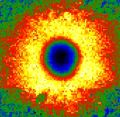Speaker
Description
Cesium lead bromide (CsPbBr3) has attracted significant attention [1] for its exceptional optoelectronic properties, including high photoluminescence yield [2] and low non-radiative lifetimes [3]. Additionally, its cost-effective synthesis methods [4] make it particularly promising for applications in light-harvesting devices like photovoltaics [5] and radiation detection [6]. However, achieving comprehensive understanding of charge carrier behavior at the nanoscale in CsPbBr3 remains a challenge.
This study utilizes advanced high-resolution techniques, such as Kelvin probe force microscopy (KPFM), steady-state and time-resolved photoluminescence (PL and TRPL), in combination with aperture-type near-field optical microscopy (a-SNOM), to delve into properties of CsPbBr3. A novel contribution introduced by our group is the utilization of near-field time-resolved photoluminescence measurements, which we aim to correlate with results obtained from confocal microscopes (far-field approaches such as fluorescence lifetime imaging microscopy, FLIM). KPFM measurements conducted both in darkness and under light exposure show a shift in contact potential difference, suggesting the transport of electrons from the surface. These insights provide valuable information about the spatial variability of electronic properties in CsPbBr3, pushing the boundaries of nanoscale characterization and supporting the development of next-generation CsPbBr3 devices. By comparing these near-field and far-field techniques, we seek to establish a comprehensive understanding of the optoelectronic properties of perovskite materials.

